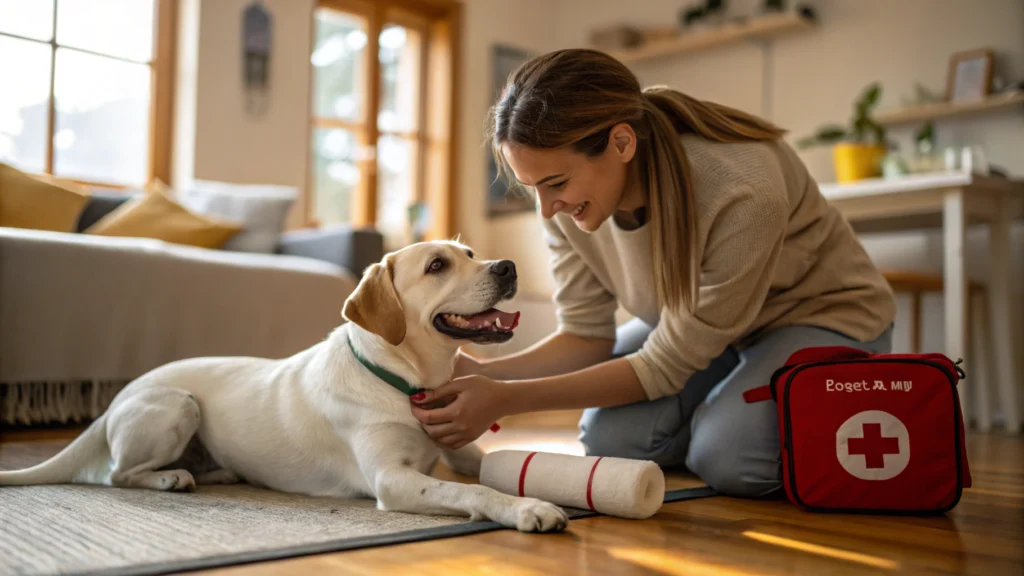
Introduction
The Urge to Treat Wounds On Pets
When a dog’s playful day at the park results in scrapes and nicks, the owner is going to search through his or her medicine cabinet. The owner’s first question is probably going to be, can you put Neosporin on a dog? Neosporin is a relatively common topical antibiotic ointment and available for purchase in a variety of stores. Neosporin is a standard ear of safety first aid when we get cuts. However, dog body is not human body which is no reason to not consider how it works.
Overview of the Neosporin & Its Typical Use
Neosporin is a topical salve that serves the purpose of stopping bacterial infections for minor human wounds. It is easy to purchase and resale in a number of stores, it seems tempting to use it for our pets. But dogs are different animal in terms of skin and behavior, so one must think long and hard before thinking it can be sprayed on. This article will present the science, the risks, and alternatives when considering what to do used on on dogs.
Identifying Neosporin
Active Ingredients: Neomycin, Polymyxin B, Bacitracin
Unquestionably, Neosporin treats wounds because of the 3 active antibiotics, neomycin, polymyxin B, and bacitracin. Each of these antibiotics target different bacterial strains of bacteria giving Neosporin a broader spectrum of possible use. Neomycin inhibits protein synthesis, polymyxin B alters cell membranes, and bacitracin inhibits cell wall synthesis. Three different targets to keep infection from taking root, but the issue still remains as to the impact Neosporin has on dogs.
Mechanism of Action Against Bacteria
These antibiotics are very good at stopping the growth of bacteria on human skin. When they are used topically, they promote a localized antimicrobial environment to protect cuts and scrapes against infection. Would using Neosporin on a dog be effective in the same way? The mechanism may still be theoretically possible, but it is important to note that canine skin has different pH and microbiomes which introduce variables that can impact the effectiveness of a topical antibiotic like Neosporin.
Is Neosporin Safe to Use on Dogs?
Veterinary Opinion on Topical Antibiotics
Veterinarians will give a tentative thumbs up to using Neosporin on your dog for minor dog wounds. Dr. Danel Grimmett, a veterinarian who spoke with the AKC, said that small amounts of Neosporin are probably okay with certain caveats. The approval of use would depend on the wound type, dog behavior, among factors to help guide the owner on seeking professional advice.
Potential for Minor Wounds
For minor scrapes or abrasions, Neosporin may actually halt the spread of bacteria thereby allowing for speedy healing. The occlusive nature of petroleum will help promote a wet environment is supportive of tissue repair. Can you put Neosporin on a dog’s minor scrape? Theoretically, it would be possible, and in a controlled context it could serve as a stopgap if used off-label, however, the potential benefits would have to be weighed against the potential risk.
Risks and Side Effects
Allergic Reactions and Skin Sensitivities
Some dogs have exhibited hypersensitivity to some of the components within Neosporin, specifically the ingredient neomycin. Signs of hypersensitivity include redness, swelling, or hives at the application site. A patch test, applying a small amount of the product to non-affected skin, can be performed before use to avoid adverse reactions from hypersensitivity. Ensuring sensitivities are avoided can lessen the wound severity and improve therapeutic effects.
Toxicity with Ingestion
One event that presents a notable risk when Neosporin is applied, is that dogs will lick their wounds. If Neosporin is ingested, it can cause gastrointestinal problems by ruining gut flora which will lead to vomiting or diarrhea. Neomycin has also been known to lead to ototoxicity if given systemically, but the risk involved for topical is much lower (Oishi, N., et al., 2012, Veterinary Clinics of North America: Small Animal Practice. Can you apply Neosporin on a dog without precautions? The risk of ingestion is a reason to be on high alert.
Scientific Evidence and Studies
Neomycin’s Ototoxicity Studies
Previous studies show neomycin can cause hearing loss in dogs through the method of injection to achieve systemic concentrations. An article summarizing various studies examining ototoxicity published in the Veterinary Clinics of North America in 2012, of note to the article was that topical is less likely to cause ototoxicity (Oishi, N., et al., 2012). It is still important to try to minimize how much is ingested to avoid absorption systemically. Source
Research on Wound Healing in Dogs Research on wound healing in dogs, supports keeping a clean, moist environment to encourage healing. A study published in Frontiers in Veterinary Science researched the canine gut microbiome and why it is important for healing in dogs. Researchers warned that items we ingest like Neosporin may shift that balance if we are not careful (Pilla, R., et al. 2020. Can you put Neosporin on a dog without realizing these effects. ); and that is just common scientific sense. Source
Guidelines for Using Neosporin on Dogs Cleaning the Wound First Before applying Neosporin you should clean the wound with soap and water or saline solution. Cleaning removes dirt and bacteria from the wound and helps Neosporin work more effectively. You should also dry the wound very well to avoid excess moisture inside the bandage that can invite infection. If you don’t clean the wound, you may end up applying ointment over dirt that allows bacteria to flourish, which undermines the whole treatment idea itself.
Preventing Licking and Ingestion You will have to make sure that your dog doesn’t lick or ingest the ointment or the bandage. You can use an Elizabethan collar or breathable bandaging to try to prevent licking but the bandaging should be tight but not impairing circulation. If your dog can’t lick the bandage itself but the ointment is tasty there is a chance that your dog will lick the bandage. If your veterinarian approves bitter sprays after bandaging, it may deter licking but a collar may be necessary to prevent actual ingestion. Can you put Neosporin on a dog safely? To be sure the ointment stays effective, you have to try to limit licking by all means.
Safer Alternatives to Neosporin
Veterinary-Approved Antiseptics
Chlorhexidine or povidone-iodine designed for pets will provide you with comparable antimicrobial activity without the risks of Neosporin. You may even use Vetecyn Plus when treating a dog’s wound which is nontoxic in case the animal was to lick at the medication. They are also inherently safer and effective. Source
Using Natural Options for Smaller Wounds
Manuka honey has natural antibacterial properties, and no toxicities related to getting it in a wound. Saline solutions are also a good option to clean out wounds that promote natural recovery. So, can you put Neosporin on a dog when there are safer options? Natural options can work just fine for minor injuries – meaning less need for human medication!
When to Refer to Your Veterinary Practice
How To Identify Serious Wounds
You will need to seek immediate veterinary assistance if your dog has a wound that is deep, bleeding, or infected with pus and/or swelling and/or foul smell. Puncture wounds from canine bites have bacteria that is beyond the reach of Neosporin. Wounds that require veterinary intervention should not be delayed as abscesses or systemic infection could jeopardize your dog’s health.
Why Professional Assessment is Important
Veterinarians provide an assessment of the wound severity, prescribe treatment options that may include antibiotics, and develop a treatment plan or address any issue that contributed to the condemnation of the wound healing. In severe wounds your vet may advise systemic antibiotics for the development of systemic infection, apply sutures in their surgical department, and otherwise provide treatment recommendations that are considerably outside of Neosporin’s capabilities. So, can you put Neosporin on a dog? Neosporin should be reserved for superficial scratches and they may require direct and immediate examination of your animal by a Veterinarian!
Conclusion
Assessing Convenience vs Safety
Neosporin is easily available for dog owners to get their hands on, but a dog owner has to weigh the pros and cons of using it on their dogs. It can work for minor wounds only if everything is done correctly, however there are drawbacks to using Neosporin such as potential risk from ingestion and allergies in dogs. Other, safer, and effective pet derivatives will generally work better than an over-the-counter human ointments.
Canine Health is our Priority
The health of a dog’s well being depends on the evidence that surrounds its care. Sometimes we need to consult a vet, soak up information on what products are safe for pets, and monitor wounds. Can a dog have Neosporin? Only if you are careful, know what you are doing, and commit to safer products whenever possible. Healthy paws and wagging tails depend on it.
References relied upon
https://www.goodrx.com/pet-health/dog/neosporin-for-dogs
https://www.metlifepetinsurance.com/blog/pet-health/neosporin-on-dogs
https://lolahemp.com/blogs/dog-health/can-you-put-neosporin-on-a-dog
https://spotpet.com/blog/dog-tips/neosporin-for-dogs
https://www.businessinsider.com/guides/pets/can-you-put-neosporin-on-a-dog
https://www.embracepetinsurance.com/waterbowl/article/neosporin-on-dogs-safety-guide
you may like it







